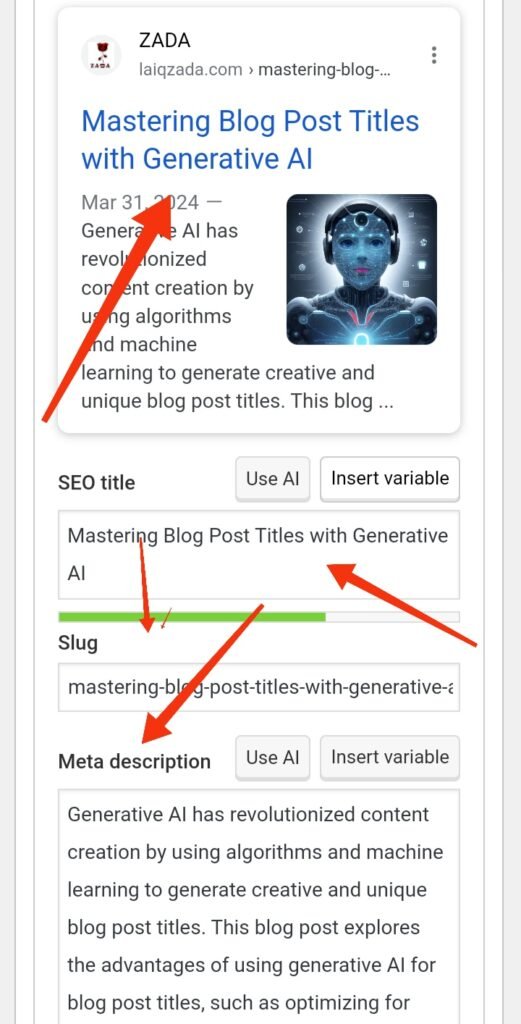Generative AI, also known as artificial intelligence, has revolutionized many industries, including content creation.
It uses algorithms and machine learning to generate creative and unique content, such as blog post titles.
With generative AI, you no longer have to rely solely on your own creativity or spend hours brainstorming for catchy titles.
Instead, you can harness the power of technology to assist you in creating attention-grabbing titles that will captivate your readers.
One of the main advantages of using generative AI for blog post titles is its ability to analyze vast amounts of data and identify patterns.
By examining popular blog posts, trending topics, and relevant keywords, generative AI can generate titles that are optimized for search engine.
This means that your blog posts will have a higher chance of appearing in search engine results, increasing the visibility of your website and attracting more organic traffic.
Furthermore, generative AI can help you overcome writer’s block by providing you with a multitude of title options.
It can generate titles based on different themes, emotions, or target audiences, allowing you to choose the one that best aligns with your content.
This not only saves you time and effort but also ensures that your titles are diverse and tailored to your specific audience’s preferences.
Another benefit of using generative AI for blog post titles is the element of surprise and creativity it brings.
AI algorithms can come up with unexpected combinations of words and phrases, resulting in unique and attention-grabbing titles that stand out from the competition.
This can be especially useful in saturated niches where it’s challenging to come up with original ideas.
However, it’s important to note that while generative AI can be a valuable tool for generating blog post titles, it should not replace human creativity and judgment.
AI-generated titles should be used as a starting point or source of inspiration, and it’s essential to review and refine them to ensure they align with your brand voice and content goals.
Generative AI offers a powerful solution for creating catchy and engaging blog post titles.
It leverages data analysis, pattern recognition, and creative algorithms to generate titles that are optimized for SEO, diverse, and unique.
By incorporating generative AI into your content creation process, you can save time, overcome writer’s block, and attract more readers to your website.
Generative AI, also known as generative adversarial networks (GANs), is a subset of artificial intelligence that focuses on creating new and original content.

GANs consist of two neural networks: a generator and a discriminator. The generator creates new content, such as images, text, or even blog post titles, while the discriminator evaluates the generated content and provides feedback to help improve the generator’s output.
Applications of Generative AI
The applications of generative AI are vast and diverse, spanning across various industries.
One of the most prominent applications is in the field of art and design. Generative AI algorithms can be used to create unique and aesthetically pleasing artwork, ranging from paintings to sculptures.
Artists can leverage these algorithms to explore new creative possibilities and push the boundaries of traditional art forms.
In the entertainment industry, generative AI has revolutionized the way movies, music, and video games are created.
Filmmakers can use GANs to generate realistic visual effects, bringing to life fantastical creatures and immersive environments.
Musicians can employ generative AI to compose original melodies and harmonies, providing them with a constant stream of creative inspiration.
Another area where generative AI has made significant strides is in the field of healthcare.
Researchers are utilizing GANs to generate synthetic medical images, which can aid in the diagnosis and treatment of various diseases.
These generated images can be used to train and improve medical imaging algorithms, enabling more accurate and efficient diagnoses.
Generative AI is also being applied in the realm of fashion and design. Fashion designers can use GANs to generate new and innovative clothing designs, helping them stay ahead of trends and create unique garments.
Additionally, generative AI algorithms can assist in the creation of virtual fashion models, reducing the need for physical prototypes and enabling rapid iterations in the design process.
Furthermore, generative AI has found applications in the field of natural language processing. Language models powered by GANs can generate coherent and contextually appropriate text, which can be used for various purposes, such as content creation, chatbots, and language translation.
These models have the potential to revolutionize the way we communicate and interact with technology.
Overall, the applications of generative AI are continuously expanding, and its potential to revolutionize various industries is immense.
As the technology advances, we can expect to see even more innovative and creative use cases emerge, pushing the boundaries of what is possible with artificial intelligence.
Using Generative AI for Blog Post Titles

Generative AI can be a powerful tool for generating blog post titles that are creative, engaging, and tailored to your target audience.
Here are some tips on how to master blog post titles using generative AI:
1. Understand your target audience:

Before you can generate effective blog post titles using generative AI, it’s crucial to have a deep understanding of your target audience. Consider their interests, pain points, and what kind of content they are looking for. This will help you create titles that resonate with them and grab their attention.
2. Train your AI model:
To generate blog post titles using generative AI, you need to train your AI model with relevant data.
This data can include existing blog post titles, keywords, and even popular topics in your niche.
By feeding this data into the AI model, it can learn patterns and generate titles that align with your content strategy.
3. Experiment with different input parameters:
Generative AI models often allow you to tweak various input parameters to generate different outputs.
For blog post titles, you can experiment with parameters like tone (serious, humorous, informative), length (short, medium, long), and style (question, statement, listicle).
By playing around with these parameters, you can generate a wide range of titles and choose the ones that best suit your content.
4. Refine and personalize the generated titles:
While generative AI can generate titles, it’s important to remember that they are just starting points.
Take the generated titles and refine them to make them more compelling and personalized.
Consider adding specific keywords, making them more actionable, or adding a touch of creativity to make them stand out.
5. Test and analyze the performance:
Once you have generated a set of blog post titles using generative AI, it’s time to test their performance.
Publish different titles and track their click-through rates, engagement, and conversions.
This data will help you understand which titles are resonating with your audience and which ones need further refinement.
6. Iterate and improve:
Generative AI is not a one-time solution. It’s an ongoing process of iteration and improvement. Continuously analyze the performance of your generated titles, gather feedback from your audience, and make adjustments accordingly. This will help you refine your generative AI model and create even more effective blog post titles in the future.
In conclusion, generative AI can be a valuable tool for generating blog post titles that capture your audience’s attention and drive engagement.
By understanding your target audience, training your AI model, experimenting with different input parameters, refining the generated titles, and continuously iterating and improving, you can master the art of using generative AI for blog post titles.
Once you have gathered a substantial dataset of existing blog post titles, you can start the process of training the AI model.
This step is crucial as it lays the foundation for the AI’s ability to generate new and relevant titles. Training an AI model involves exposing it to a vast amount of data and allowing it to learn patterns and correlations within that data.
There are various techniques and algorithms that can be used to train an AI model, but one popular approach is using a deep learning framework such as TensorFlow or PyTorch.
These frameworks provide a set of tools and libraries that simplify the process of training complex AI models.
Before feeding the dataset into the AI model, it is important to preprocess the data to ensure its quality and consistency.
This may involve removing duplicates, correcting spelling errors, or standardizing the format of the titles.
Preprocessing the data helps to improve the accuracy and effectiveness of the AI model.
Once the dataset is prepared, it is time to feed it into the AI model.
The model will analyze the dataset and learn the underlying patterns and structures of the blog post titles.
This process involves adjusting the weights and biases of the model’s neural network through a process called backpropagation.
During the training process, it is essential to monitor the performance of the AI model.
This can be done by evaluating its ability to generate new titles based on the training dataset.
Metrics such as accuracy, precision, and recall can be used to measure the model’s performance. If the model is not performing well, adjustments can be made to the training process, such as changing the hyperparameters or increasing the size of the dataset.
Training an AI model can be a time-consuming and computationally intensive task.
It may require significant computational resources and expertise in machine learning. However, the results can be highly rewarding, as a well-trained AI model can generate high-quality and engaging blog post titles that resonate with your target audience.
Defining the parameters for generating blog post titles is a crucial step in utilizing the AI model effectively.
By specifying the length of the title, you can ensure that it fits within the character limits of various platforms or conforms to your preferred style. For example, if you want concise and catchy titles, you may set a maximum length of 60 characters.
In addition to length, you can also determine the tone or style you want the titles to convey.
This allows you to align the generated titles with your brand image or the overall theme of your blog. For instance, if your blog focuses on providing informative and educational content, you may want the titles to have a professional and authoritative tone.
Furthermore, you have the option to include specific keywords or themes in the generated titles. This is particularly useful if you want to optimize the titles for search engine optimization (SEO) purposes. By incorporating relevant keywords, you can increase the chances of your blog posts being discovered by search engine users.
It is worth mentioning that the AI model takes these parameters into account when generating titles. By providing clear and specific guidelines, you can ensure that the titles generated align with your preferences and meet your criteria. However, it is important to strike a balance between giving the AI model enough freedom to be creative and providing sufficient guidance to achieve the desired results.
Overall, defining the parameters for generating blog post titles empowers you to tailor the AI model’s output to suit your specific needs. Whether you want attention-grabbing titles for social media sharing or SEO-optimized titles for organic search traffic, specifying the length, tone, and keywords will enable the AI model to generate titles that resonate with your target audience and enhance the visibility of your blog.
Iterative refinement is a crucial step in the process of generating blog post titles using generative AI. It allows for continuous improvement and fine-tuning of the AI model to produce more accurate and relevant titles. Once the initial output is generated, it is important to carefully evaluate the titles and provide feedback on their quality.
During the evaluation process, you can identify which titles are effective in capturing the essence of the blog post and engaging potential readers. You may also notice some titles that are not as compelling or fail to convey the main message of the post. This feedback is invaluable as it helps the AI model understand what works and what doesn’t in terms of generating appealing titles.
Based on the feedback received, adjustments can be made to the AI model. This could involve tweaking the underlying algorithms, modifying the training data, or redefining the parameters used in the title generation process.
By iteratively refining the model, the AI system becomes more adept at understanding the nuances of blog post titles and can generate more accurate and captivating options.
It is important to note that the iterative refinement process is not a one-time event. It is an ongoing cycle of generating titles, evaluating their effectiveness, providing feedback, and making necessary adjustments. Each iteration brings the AI model closer to producing titles that align with the desired objectives and resonate with the target audience.
Over time, as the AI model learns from the feedback provided, it becomes increasingly proficient in generating high-quality blog post titles.
The refinement process helps the model adapt to changing trends, preferences, and audience expectations, ensuring that the titles it generates remain relevant and compelling.
Furthermore, the iterative refinement process also allows for continuous learning and improvement from the human side.
As you evaluate the AI-generated titles and provide feedback, you gain a deeper understanding of what makes a title effective and engaging. This knowledge can be applied to future content creation, enhancing your own skills as a writer and marketer.
In conclusion, iterative refinement is a crucial step in the process of generating blog post titles using generative AI.
It enables continuous improvement, aligns the AI model with the desired objectives, and ensures that the titles generated are relevant and captivating.
Through this iterative process, both the AI model and the human evaluator can learn and grow, resulting in more effective and engaging blog post titles.
4. Combining Creativity and SEO

While generative AI can help you come up with creative and engaging blog post titles, it’s important to also consider SEO (search engine optimization) when crafting your titles.
SEO helps your blog posts rank higher in search engine results, driving more organic traffic to your website.
Make sure to include relevant keywords in your titles, but avoid keyword stuffing or using overly generic titles.
Strive for a balance between creativity and SEO to maximize the impact of your titles.
When it comes to combining creativity and SEO, it’s crucial to understand the importance of both aspects.
Creativity is what captures the attention of your audience and makes them want to click on your blog post.
It’s what sets you apart from the competition and makes your content unique.
On the other hand, SEO ensures that your content is discoverable by search engines and reaches a wider audience.
One way to combine creativity and SEO is by conducting keyword research.
This involves identifying the keywords and phrases that your target audience is using to search for information related to your blog post topic.
By incorporating these keywords into your title, you can increase the chances of your blog post appearing in search engine results.
However, it’s important to avoid keyword stuffing, which is the excessive use of keywords in an unnatural way.
Search engines have become smarter and can easily detect keyword stuffing, penalizing websites that engage in this practice. Instead, focus on creating titles that are both creative and informative, while naturally incorporating relevant keywords.
Another way to combine creativity and SEO is by using descriptive and engaging meta tags.
Meta tags provide a summary of your blog post and appear in search engine results. By crafting compelling meta tags that include relevant keywords, you can increase the likelihood of users clicking on your link.
Remember to keep your meta tags concise and accurate, providing a clear preview of what your blog post is about.
In addition to keywords and meta tags, consider the structure and formatting of your titles.

Search engines often prioritize titles that are clear, concise, and easy to read. Use headings and subheadings to organize your content and make it more scannable for both search engines and readers.
Incorporate relevant keywords naturally into these headings to further optimize your blog post.
Ultimately, combining creativity and SEO is about finding a balance.
While it’s important to prioritize creativity to engage your audience, neglecting SEO can limit the reach of your content.
By conducting keyword research, using descriptive meta tags, and optimizing the structure of your titles, you can create blog post titles that are both creative and SEO-friendly, maximizing their impact and driving more traffic to your website.
5. Human Touch

While generative AI can assist you in generating blog post titles, it’s important to remember the human touch.
AI can provide suggestions and inspiration, but ultimately, it’s up to you as the writer to craft a title that resonates with your audience.
Use the generated titles as a starting point and customize them to fit your unique style and brand voice. Trust your instincts and rely on your creativity to create titles that stand out.
When it comes to creating engaging and captivating titles, there are a few key elements to consider. Firstly, think about the purpose of your blog post.
Is it informative, entertaining, or persuasive? Understanding the goal of your content will help you tailor the title to attract the right audience.
Secondly, consider the tone and style of your writing.
Are you aiming for a casual and conversational tone, or do you prefer a more formal and authoritative approach?
The title should reflect the overall tone of your blog post and give readers a glimpse into what they can expect from your writing.
Additionally, it’s important to think about the keywords and phrases that are relevant to your topic.
Incorporating these into your title can help improve search engine optimization (SEO) and increase the visibility of your blog post.
However, be careful not to overdo it and make the title sound forced or unnatural. Balance is key.
Furthermore, consider the length of your title. While shorter titles can be punchy and attention-grabbing, longer titles may provide more context and entice readers to click.
Experiment with different lengths and see what works best for your specific audience and content.
Lastly, don’t be afraid to get creative and think outside the box.
Sometimes, a unique and unexpected title can capture readers’ attention and make them curious to learn more. Brainstorm different angles, play with words, and let your imagination run wild.
In conclusion, while AI can be a helpful tool in generating blog post titles, it’s crucial to infuse your own human touch to make them truly impactful.
By considering the purpose, tone, keywords, length, and creativity, you can create titles that not only attract readers but also reflect your unique writing style and brand voice.



